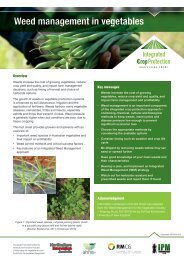vegetables
VA-NovDec2015
VA-NovDec2015
You also want an ePaper? Increase the reach of your titles
YUMPU automatically turns print PDFs into web optimized ePapers that Google loves.
30<br />
Ask the industry<br />
THERE ARE MANY TERMS IN THE<br />
HORTICULTURAL CROP PROTECTION<br />
MARKET THAT WE ALL USE AND<br />
HEAR FREQUENTLY, BUT MAY<br />
NOT COMPLETELY UNDERSTAND.<br />
SYNGENTA TECHNICAL SERVICES<br />
LEAD SCOTT MATHEW EXPLAINS<br />
SOME OF THE MOST COMMON TERMS<br />
THAT ARE USED ON A REGULAR<br />
BASIS IN THE INDUSTRY.<br />
Mode of action (MOA)<br />
describes the biochemical<br />
processes by which the<br />
fungicide you apply controls the<br />
disease (for example, disrupting<br />
cell wall synthesis).<br />
Target site is the exact location<br />
within the disease where the<br />
crop protection product works,<br />
such as interfering with the<br />
activity of a specific enzyme<br />
within a metabolic pathway.<br />
Protectant/contact fungicides<br />
(see below) work on plant<br />
surfaces where they form a<br />
chemical barrier between the<br />
plant and fungus. There is no<br />
movement of the fungicide<br />
into the plant. Protectant<br />
fungicides must be applied<br />
prior to infection and re-applied<br />
to new growth if conditions<br />
remain favourable for disease<br />
development.<br />
Contact activity<br />
Fungicides that penetrate<br />
plant tissue following the<br />
application (and also function<br />
as a protectant fungicide at the<br />
site of contact) are generally<br />
labelled as systemic fungicides.<br />
This can cause confusion in<br />
the market because many<br />
understand the term ‘systemic’<br />
to mean that the fungicide<br />
applied to one section of the<br />
plant will move around within<br />
the plant to control disease in<br />
other areas. Fungicides labelled<br />
as systemic have very different<br />
degrees of systemic movement.<br />
Translaminar fungicides (see<br />
below) move through the leaf<br />
or plant tissue from the side in<br />
which they are applied, to the<br />
direct opposite side of the leaf<br />
or plant tissue.<br />
Translaminar activity<br />
Xylem mobile fungicides (see<br />
below) move in an upward/<br />
outwards direction from where<br />
they are applied in plants with<br />
water through the xylem – the<br />
water-conducting tissue of the<br />
plant. This movement is also<br />
known as acropetal movement.<br />
Leaf or locally systemic activity<br />
Xyleme mobile<br />
Fully systemic fungicides (see<br />
below) move both upward<br />
through the xylem, and<br />
downward through the phloem,<br />
or the food conducting tissue<br />
of the plant. This movement is<br />
also sometimes described as<br />
basipetal movement. Very few<br />
fungicides and insecticides<br />
registered in Australia are<br />
classed as fully systemic.<br />
Plant systemic activity<br />
Phloem mobile<br />
with Scott Mathew<br />
Please ask your local reseller<br />
or consultant how the crop<br />
protection product you are<br />
applying works either on the<br />
plant surface or within the plant.<br />
For example, is it a protectant/<br />
contact, translaminar, xylem<br />
mobile or a fully systemic<br />
product?<br />
Understanding how the crop<br />
protection product moves<br />
within the plant will help you to<br />
better set up your application<br />
equipment to maximise the<br />
performance of the crop<br />
protection product applied.<br />
i<br />
For more information or<br />
to ask a question, please<br />
contact your local Syngenta<br />
Territory Manager, the<br />
Syngenta Advice Line on<br />
1800 067 108, visit www.<br />
syngenta.com.au or email<br />
Vegetables Australia: info@<br />
ausveg.com.au. Please note<br />
that your questions may be<br />
published.





